
Cummins Inc. is an American multinational corporation that designs, manufactures, and distributes engines, filtration and power generation products. Cummins also services engines and related equipment, including fuel systems, controls, air handling, filtration, emission control, electrical power generation systems, and trucks.

Joseph Charles Arthur was a pioneer American plant pathologist and mycologist best known for his work with the parasitic rust fungi (Pucciniales). He was a charter member of the Botanical Society of America, the Mycological Society of America, and the American Phytopathological Society. He was an elected member of both the American Philosophical Society and the American Academy of Arts and Sciences. He was a recipient of the first Doctorate in Sciences awarded by Cornell University. The standard author abbreviation Arthur is used to indicate this person as the author when citing a botanical name.
Cummins Lakes Provincial Park and Protected Area is a provincial park and protected area located in the eastern interior of British Columbia, Canada. It was established on August 4, 2000 to protect mountainous wilderness along the Cummins River.
Max Norman is a British record producer and recording engineer active since 1973. He produced many acclaimed heavy metal releases.

Wheat leaf rust is a fungal disease that affects wheat, barley, rye stems, leaves and grains. In temperate zones it is destructive on winter wheat because the pathogen overwinters. Infections can lead up to 20% yield loss. The pathogen is a Puccinia rust fungus. It is the most prevalent of all the wheat rust diseases, occurring in most wheat-growing regions. It causes serious epidemics in North America, Mexico and South America and is a devastating seasonal disease in India. P. triticina is heteroecious, requiring two distinct hosts.
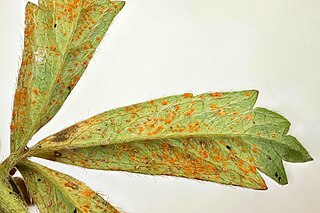
Frommeella tormentillae is a species of rust fungus in the family Phragmidiaceae. It is a plant pathogen affecting the strawberry.

Phragmidium mucronatum is a plant pathogen that causes rose rust.
Vladimir Andreevich Tranzschel was a botanist, mycologist and plant pathologist, especially an expert on rust fungi. He lived in the Russian Empire and then in the Soviet Union.

Rust is a multi-paradigm, general-purpose programming language that emphasizes performance, type safety, and concurrency. It enforces memory safety, meaning that all references point to valid memory, without requiring the use of automated memory management techniques, such as garbage collection. To simultaneously enforce memory safety and prevent data races, its "borrow checker" tracks the object lifetime of all references in a program during compilation. Rust was influenced by ideas from functional programming, including immutability, higher-order functions, and algebraic data types. It is popular for systems programming.
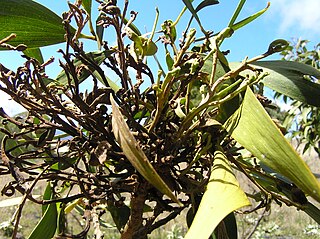
The Pileolariaceae are a family of rust fungi in the order Pucciniales. A 2008 estimate places contains 4 genera and 34 species in the family.
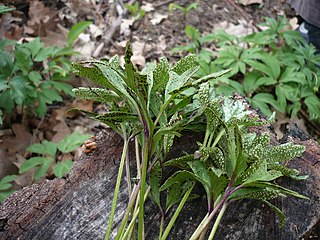
The Uropyxidaceae are a family of rust fungi in the order Pucciniales. The family contains 15 genera and 149 species.
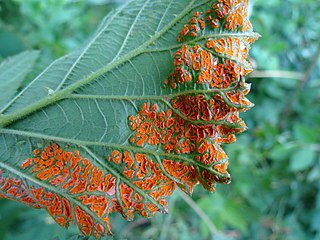
Arthuriomyces is a genus of rust fungi in the family Phragmidiaceae. The genus contains three species that are found in North America, Russia, China, and Japan. The genus is named in honor of American botanist Joseph Charles Arthur, noted for his research on rust fungi.
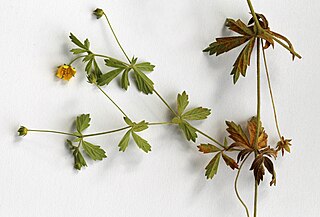
Frommeella (Frommeëlla) is a genus of rust fungi in the family Phragmidiaceae. The widespread genus contains two species.
Maravalia is a genus of rust fungi in the Chaconiaceae family. The widespread genus contains about 35 species that grow on angiosperms.
George Baker Cummins was a notable American mycologist and was considered an authority on the rust fungi. At his death he was the last surviving charter member of the Mycological Society of America.
Elliot Calvin Howe was an American botanist and a member of the Torrey Botanical Club. Most notably, he discovered several species of fungi throughout his life, including Tricholoma Peckii, Hygrophorus Peckianus, Puccinia curtipes, P. Peckianus, Microsphaera menispermi, M. platani and M. symphoricarpi, and two were named after him to commemorate his contributions to the field, Stropharia Howeanum Pk. and Hypoxylon Howeanum Pk.

4-Fluoroestradiol (4-FE2) is a synthetic estrogen and a derivative of estradiol which was never marketed. It is specifically the 4-fluoro analogue of estradiol. 4-Fluoroestradiol has 180 ± 43% of the affinity of estradiol for the estrogen receptor of rat uterine cytosol and shows potent uterotrophic activity similar to that of estradiol in mice and rats. It has been labeled with fluorine-18 (18F) for potential use in medical imaging.
Pucciniosira is a genus of rust fungi belonging to the family Pucciniosiraceae.

The Zaghouaniaceae are a family of rust fungus genera, some of which have long been considered incertae sedis in the order Pucciniales, based on the type genus Zaghouania. The classification of fungal taxa based on only morphological characteristics has long been recognised as problematical, so this order was reviewed over a long-term study using three DNA loci and published in 2021.
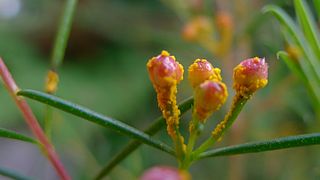
The Sphaerophragmiaceae are a family of rust fungus genera in the order Pucciniales, based on the type genus Sphaerophragmium and placed in the suborder Uredinineae.













